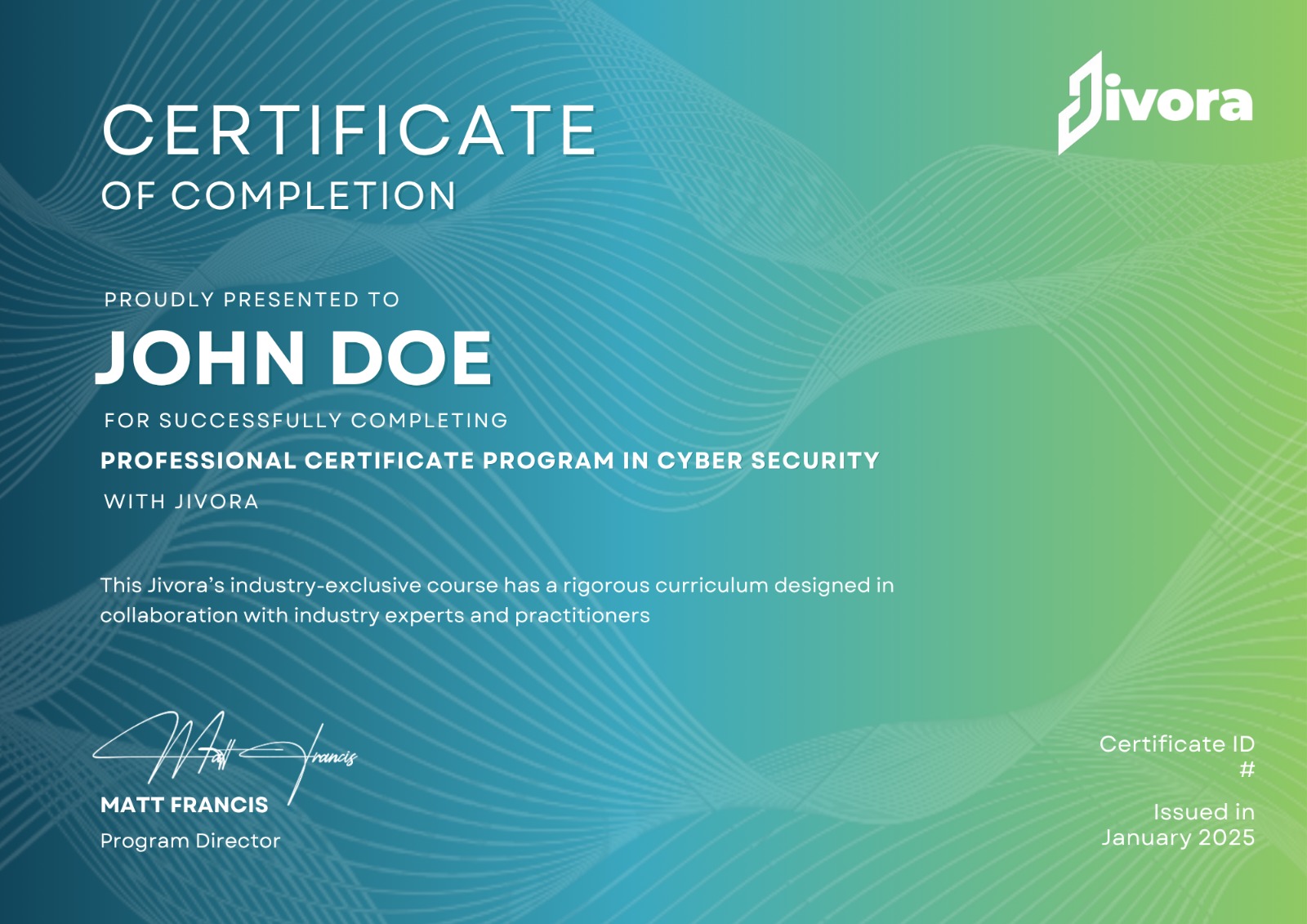
in collaboration with

Advance your career with Jivora’s Cybersecurity Course — a rigorous 06-month curriculum designed to prepare professionals for the dynamic and fast-growing field of digital security.
Develop in-depth expertise in areas such as ethical hacking, network defense, vulnerability assessment, cloud security, and compliance with global cyber laws. The program emphasizes hands-on learning through real-world simulations, capstone projects, and mentorship from industry experts.
Whether you're entering the field or enhancing your current skill set, Jivora’s Cybersecurity certification equips you with the practical knowledge, professional credibility, and portfolio required to excel in today’s high-demand cybersecurity roles.
Enroll in Jivora’s Cybersecurity Program to develop job-ready skills, gain practical experience, and launch a rewarding career in one of the most in-demand fields in tech today.
This module provides a comprehensive introduction to the Linux operating system, a critical platform for cybersecurity and ethical hacking practices. Participants will develop practical skills in navigating the Linux command-line interface, managing file systems, configuring user and group permissions, and monitoring system processes. The course also introduces basic shell scripting to automate routine administrative and security tasks. Emphasis is placed on preparing and optimizing Linux environments specifically for penetration testing and security assessments, enabling learners to work efficiently within industry-standard tools and frameworks.
Linux architecture and file system hierarchy
Command-line operations and introductory shell scripting
User and group management techniques
File permissions and access control mechanisms
System monitoring and process management
Configuration of Linux environments for ethical hacking activities
Linux System Administration focuses on managing and maintaining Linux-based systems, which are critical for modern IT infrastructure and cybersecurity operations. This module covers core administrative tasks such as user and group management, file system structure, permissions, process control, package installation, service management, and system monitoring.
Learners will gain hands-on experience with command-line operations, shell scripting, and troubleshooting techniques used to ensure optimal system performance and security. By the end of this module, students will be equipped to configure, secure, and manage Linux environments—laying a strong foundation for advanced roles in cybersecurity and network administration.
User and Permission Management
File System Navigation and Configuration
Process and Service Management
Software and Package Management
System Monitoring and Security Hardening
This module introduces learners to the core principles and practices of ethical hacking, emphasizing its critical role in identifying and addressing security weaknesses within systems, networks, and applications. Ethical hacking, also known as white-hat hacking or penetration testing, involves authorized and controlled attempts to simulate cyberattacks to uncover vulnerabilities before malicious actors can exploit them.
Students will explore the methodologies and tools used by ethical hackers, understand the importance of permission and legal boundaries, and learn how to conduct systematic assessments. The module also covers reporting techniques to communicate findings effectively and support organizations in strengthening their cybersecurity posture.
Legal and ethical considerations in penetration testing
Planning and scope definition for authorized hacking
Vulnerability scanning and exploitation techniques
Security control assessment and bypass methods
Documentation and reporting of security findings
The role of ethical hackers in proactive defense strategies
Gain an in-depth understanding of critical cybersecurity threats that commonly target individuals and organizations. Learn how phishing attacks exploit human vulnerabilities by tricking users into divulging sensitive information through fraudulent emails, websites, and communication channels. Examine various password cracking techniques, including brute-force, dictionary, and rainbow table attacks, highlighting the dangers posed by weak authentication practices. Explore the covert operation of keyloggers that capture keystrokes, and spyware that monitors user activity to steal confidential data. This program emphasizes identifying attacker tactics and implementing robust countermeasures. Combining theoretical knowledge with hands-on practice, you will develop the expertise required to detect, mitigate, and prevent these threats effectively in professional cybersecurity environments.
Proxy Server Architecture
Types of Proxy Servers
Role of Anonymizers in Online Privacy
Applications in Cybersecurity
Detection and Risk Mitigation
Gain a comprehensive understanding of some of the most prevalent and impactful cybersecurity threats targeting individuals and organizations. Explore how phishing attacks manipulate users into revealing sensitive information through deceptive emails, websites, or communication platforms. Study various password cracking techniques such as brute-force, dictionary, and rainbow table attacks, and assess the risks associated with weak authentication mechanisms. Learn how keyloggers operate to covertly capture user keystrokes, and how spyware silently monitors digital activity to extract confidential data. Emphasis is placed on identifying the tactics used by threat actors and implementing effective countermeasures. Through a blend of theoretical insight and practical application, develop the skills necessary to detect, mitigate, and prevent these threats in real-world cybersecurity environments.
Phishing Techniques and Prevention
Password Cracking Methods
Keylogger Functionality and Detection
Spyware Analysis and Mitigation
Real-World Threat Simulation and Response
This section provides a foundational understanding of computer networking essential for cybersecurity professionals. It covers various types of networks, including LAN, WAN, and MAN, alongside common network topologies. Students will study critical communication protocols such as TCP/IP, HTTP, and FTP, and gain a thorough understanding of the OSI and TCP/IP models to conceptualize data flow across network layers. The course also explores key networking devices—routers, switches, and firewalls—highlighting their roles in traffic management and security enforcement.
Core concepts of IP addressing and subnetting will be examined to illustrate device identification and network segmentation. Through a blend of theoretical knowledge and practical application, learners will develop the skills necessary to analyze network structures and implement robust security measures to safeguard digital communications.
Networks and Topologies
Core Network Protocols
OSI and TCP/IP Models
Networking Devices and Their Roles
IP Addressing and Subnetting
The Security Operations Center (SOC) is the frontline defense for any organization’s cybersecurity. It’s where dedicated teams work around the clock to monitor, detect, and respond to security threats in real time. In this part of the course, you’ll learn how SOC teams operate, using advanced tools and processes to quickly identify potential attacks and stop them before they cause harm.
You’ll gain practical experience with technologies like Security Information and Event Management (SIEM) systems and understand how analysts investigate alerts and manage incidents. This section emphasizes the importance of teamwork, vigilance, and quick decision-making to keep organizations safe. By the end, you’ll be prepared to contribute effectively in a SOC environment and help protect critical digital assets against evolving cyber threats
Continuous Threat Monitoring
Incident Detection and Analysis
Use of SIEM Tools
Incident Response and Mitigation
Collaboration and Communication
Steganography focuses on concealing information within non-secret digital files, such as images, audio, video, or text, in a way that prevents detection. Unlike encryption, which makes data unreadable to outsiders, steganography hides the existence of the data itself, making it a powerful tool for secure communication.
Learners will explore modern techniques used to embed hidden messages within digital media and understand how steganography can be combined with encryption to enhance data protection. The module also includes real-world applications and use cases, as well as tools used to perform and detect steganographic methods.
Steganography and its Role in Cybersecurity
Digital Media Steganography Techniques
Steganography vs Cryptography
Hands-on with Steganography Tools
Detection and Prevention Techniques (Steganalysis)
This module provides a comprehensive overview of cryptography, focusing on its essential role in securing communications against unauthorized access and tampering. Learners will explore the fundamental principles that underpin modern cryptographic systems, including confidentiality, data integrity, authentication, and non-repudiation.
The course covers various cryptographic techniques and protocols designed to protect information exchanged between parties, ensuring that data remains private, accurate, and verifiable. Through practical examples and real-world scenarios, students will understand how cryptography defends against adversaries attempting to intercept or alter sensitive information.
Confidentiality
Data integrity
Authentication
Non-repudiation
This section focuses on understanding how social engineering exploits human behavior to gain unauthorized access to confidential information or compromise security. Key tactics such as phishing, pretexting, baiting, and impersonation will be examined, highlighting how attackers bypass technical defenses by targeting human weaknesses.
In this you will learn to recognize different social engineering methods, evaluate their potential impact on organizational security, and apply practical strategies to prevent such attacks. Emphasis is placed on raising awareness, encouraging adherence to security best practices, and fostering a vigilant approach to minimize the risk posed by these manipulative techniques.
Collection and preservation of digital evidence
Use of forensic tools for data recovery and analysis
Techniques for log examination and incident tracing
Legal and ethical considerations in digital investigations
Preparation and presentation of forensic reports
Cyber forensics focuses on the careful collection, preservation, and analysis of digital evidence to investigate cybercrimes effectively. In this section, students will learn how to trace and examine digital footprints left behind by malicious activities using a variety of forensic tools and techniques. The course emphasizes the importance of maintaining the integrity of evidence and understanding the legal and ethical responsibilities involved in cyber investigations. By gaining hands-on experience in data recovery, log analysis, and incident tracing, students will be prepared to support incident response teams and help protect digital environments through thorough and precise investigative practices.
Collection and preservation of digital evidence
Use of forensic tools for data recovery and analysis
Techniques for log examination and incident tracing
Legal and ethical considerations in digital investigations
Preparation and presentation of forensic reports






Ready to take the next step in your career? Reach out to Jivora today — our team of expert career counsellors is here to guide, support, and empower your journey!
Expert and Professional Instructors
Career's Transformed
Over the World


Jivora’s Data Science and AI program was a game-changer for me. The hands-on projects and expert mentorship prepared me perfectly for real-world challenges. Highly recommend it!
The 12-month journey with Jivora was incredible. I learned everything from Python to deep learning, and the career support team helped me land my first tech job!
As someone switching careers, I found Jivora’s curriculum extremely practical and beginner-friendly. The personalized support made learning AI and machine learning much less intimidating.
Jivora’s program exceeded all my expectations. The course structure was clear, the content was up-to-date, and the capstone projects gave me an edge in interviews.
Choosing Jivora for my Data Science and AI education was the best decision. The instructors, resources, and job support services were absolutely outstanding.